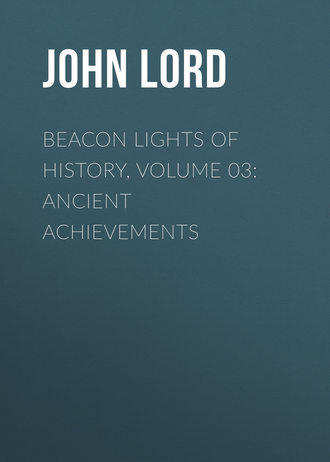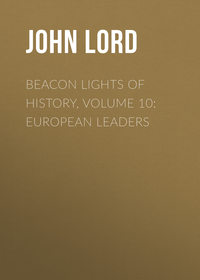 полная версия
полная версияBeacon Lights of History, Volume 03: Ancient Achievements
In Egyptian houses were handsome chairs and fauteuils, stools and couches, the legs of which were carved in imitation of the feet of animals; and these were made of rare woods, inlaid with ivory, and covered with rich stuffs. Some of the Egyptian chairs were furnished with cushions and covered with the skins of leopards and lions; the seats were made of leather, painted with flowers. Footstools were sometimes made of elegant patterns, inlaid with ivory and precious woods. Mats were used in the sitting-rooms. The couches were of every variety of form, and utilized in some instances as beds. The tables were round, square, and oblong, and were sometimes made of stone and highly ornamented with carvings. Bronze bedsteads were used by the wealthy classes.
In their entertainments nothing was omitted by the Egyptians which would produce festivity,–music, songs, dancing, and games of chance. The guests arrived in chariots or palanquins, borne by servants on foot, who also carried parasols over the heads of their masters. Previous to entering the festive chamber water was brought for the feet and hands, the ewers employed being made often of gold and silver, of beautiful form and workmanship. Servants in attendance anointed the head with sweet-scented ointment from alabaster vases, and put around the heads of the guests garlands and wreaths in which the lotus was conspicuous; they also perfumed the apartments with myrrh and frankincense, obtained chiefly from Syria. Then wine was brought, and emptied into drinking-cups of silver or bronze, and even of porcelain, beautifully engraved, one of which was exclusively reserved for the master of the house. While at dinner the party were enlivened with musical instruments, the chief of which were the harp, the lyre, the guitar, the tambourine, the pipe, the flute, and the cymbal. Music was looked upon by the Egyptians as an important science, and was diligently studied and highly prized; the song and the dance were united with the sounds of musical instruments. Many of the ornamented vases and other vessels used by the Egyptians in their banquets were not inferior in elegance of form and artistic finish to those made by the Greeks at a later day. The Pharaoh of the Jewish Exodus had drinking-vessels of gold and silver, exquisitely engraved and ornamented with precious stones.
Some of the bronze vases found at Thebes and other parts of Egypt show great skill in the art of compounding metals, and were highly polished. Their bronze knives and daggers had an elastic spring, as if made of steel. Wilkinson expresses his surprise at the porcelain vessels recently discovered, as well as admiration of them, especially of their rich colors and beautiful shapes. There is a porcelain bowl of exquisite workmanship in the British Museum inscribed with the name of Rameses II., proving that the arts of pottery were carried to great perfection two thousand years before Christ. Boxes of elaborate workmanship, made of precious woods finely carved and inlaid with ivory, are also preserved in the different museums of Europe, all dating from a remote antiquity. These boxes are of every form, with admirably fitting lids, representing fishes, birds, and animals. The rings, bracelets, and other articles of jewelry that have been preserved show great facility on the part of the Egyptians in cutting the hardest stones. The skill displayed in the sculptures on the hard obelisks and granite monuments of Egypt was remarkable, since they were executed with hardened bronze.
Glass-blowing was another art in which the Egyptians excelled. Fifteen hundred years before Christ they made ornaments of glass, and glass vessels of large size were used for holding wine. Such was their skill in the manufacture of glass that they counterfeited precious stones with a success unknown to the moderns. We read of a counterfeited emerald six feet in length. Counterfeited necklaces were sold at Thebes which deceived strangers. The uses to which glass was applied were in the manufacture of bottles, beads, mosaic work, and drinking-cups, and their different colors show considerable knowledge of chemistry. The art of cutting and engraving stones was doubtless learned by the Israelites in their sojourn in Egypt. So perfect were the Egyptians in the arts of cutting precious stones that they were sought by foreign merchants, and they furnished an important material in commerce.
From the earliest times the Egyptians were celebrated for their manufacture of linen, which was one of the principal articles of commerce; and cotton and woollen cloths as well as linen were woven. Cotton was used not only for articles of dress, but for the covering of chairs and other kinds of furniture. The great mass of the mummy cloths is of coarse texture; but the "fine linen" spoken of in the Scripture was as fine as muslin, in some instances containing more than five hundred threads to an inch, while the finest productions of the looms of India have only one hundred threads to the inch. Not only were the threads of linen cloth of extraordinary fineness, but the dyes were equally remarkable, and were unaffected by strong alkalies. Spinning was principally the occupation of women, who also practised the art of embroidery, in which gold thread was used, supposed to be beaten out by the hammer; but in the arts of dyeing and embroidery the Egyptians were surpassed by the Babylonians, who were renowned for their cloths of various colors.
The manufacture of paper was another art for which the Egyptians were famous, made from the papyrus, a plant growing in the marsh-land of the Nile. The papyrus was also applied to the manufacture of sails, baskets, canoes, and parts of sandals. Some of the papyri, on which is hieroglyphic writing dating from two thousand years before our era, are in good preservation. Sheep-skin parchment also was used for writing.
The Egyptians were especially skilled in the preparation of leather for sandals, shields, and chairs. The curriers used the same semicircular knife which is now in use. The great consumption of leather created a demand far greater than could be satisfied by the produce of the country, and therefore skins from foreign countries were imported as part of the tribute laid on conquered nations or tribes.
More numerous than the tanners in Egypt were the potters, among whom the pottery-wheel was known from a remote antiquity, previous to the arrival of Joseph from Canaan, and long before the foundation of the Greek Athens. Earthenware was used for holding wine, oils, and other liquids; but the finest production of the potter were the vases, covered with a vitreous glaze and modelled in every variety of forms, some of which were as elegant as those made later by the Greeks, who excelled in this department of art.
Carpenters and cabinet-makers formed a large class of Egyptian workmen for making coffins, boxes, tables, chairs, doors, sofas, and other articles of furniture, frequently inlaid with ivory and rare woods. Veneering was known to these workmen, probably arising from the scarcity of wood. The tools used by the carpenters, as appear from the representations on the monuments, were the axe, the adze, the hand-saw, the chisel, the drill, and the plane. These tools were made of bronze, with handles of acacia, tamarisk, and other hard woods. The hatchet, by which trees were felled, was used by boat-builders. The boxes and other articles of furniture were highly ornamented with inlaid work.
Boat-building in Egypt also employed many workmen. Boats were made of the papyrus plant, deal, cedar, and other woods, and were propelled both by sails and oars. One ship-of-war built for Ptolemy Philopater is said by ancient writers to have been 478 feet long, to have had forty banks of oars, and to have carried 400 sailors, 4,000 rowers, and 3,000 soldiers. This is doubtless an exaggeration, but indicates great progress in naval architecture. The construction of boats varied according to the purpose for which they were intended. They were built with ribs as at the present day, with small keels, square sails, with spacious cabins in the centre, and ornamented sterns; there was usually but one mast, and the prows terminated in the heads of animals. The boats of burden were somewhat similar to our barges; the sails were generally painted with rich colors. The origin of boat-building was probably the raft, and improvement followed improvement until the ship-of-war rivalled in size our largest vessels, while Egyptian merchant vessels penetrated to distant seas, and probably doubled the Cape of Good Hope.
In regard to agriculture the Egyptians were the most advanced of the nations of antiquity, since the fertility of their soil made the occupation one of primary importance. Irrigation was universally practised, the Nile furnishing water for innumerable canals. The soil was often turned up with the hoe rather than the plough. The grain was sown broadcast, and was trodden in by goats. Their plough was very simple, and was drawn by oxen; the yoke being attached to the horns. Although the soil was rich, manures were frequently used. The chief crops were those of wheat, barley, beans, peas, lentils, vetches, lupines, clover, rice, indigo, cotton, lettuce, flax, hemp, cumin, coriander, poppy, melons, cucumbers, onions, and leeks. We do not read of carrots, cabbages, beets, or potatoes, which enter so largely into modern husbandry. Oil was obtained from the olive, the castor-berry, simsin, and coleseed. Among the principal trees which were cultivated were the vine, olive, locust, acacia, date, sycamore, pomegranate, and tamarisk. Grain, after harvest, was trodden out by oxen, and the straw was used as provender. To protect the fields from inundation dykes were built.
All classes in Egypt delighted in the sports of the field, especially in the hunting of wild animals, in which the arrow was most frequently used. Sometimes the animals were caught in nets, in enclosed places near water-brooks. The Egyptians also had numerous fish-ponds, since they were as fond of angling as they were of hunting. Hunting in Egypt was an amusement, not an occupation as among nomadic people. Not only was hunting for pleasure a great amusement among Egyptians, but also among Babylonians and Persians, who coursed the plains with dogs. They used the noose or lasso also to catch antelopes and wild cattle, which were hunted with lions; the bow used in the chase was similar to that employed in war. All the subjects of the chase were sculptured on the monuments with great spirit and fidelity, especially the stag, the ibex, the porcupine, the wolf, the hare, the lion, the fox, and the giraffe. The camel is not found among the Egyptian sculptures, nor the bear. Of the birds found in their sculptures were vultures, eagles, kites, hawks, owls, ravens, larks, swallows, turtle-doves, quails, ostriches, storks, plovers, snipes, geese, and ducks, many of which were taken in nets. The Nile and Lake Birket el Keroun furnished fish in great abundance. The profits of the fisheries were enormous, and were farmed out by the government.
The Egyptians were very fond of ornaments in dress, especially the women. They paid great attention to their sandals; they wore their hair long and plaited, bound round with an ornamented fillet fastened by a lotus bud; they wore ear-rings and a profusion of rings on the fingers and bracelets for the arms, made of gold and set with precious stones. The scarabaeus, or sacred beetle, was the adornment of rings and necklaces; even the men wore necklaces and rings and chains. Both men and women stained the eyelids and brows. Pins and needles were among the articles of the toilet, usually made of bronze; also metallic mirrors finely polished. The men carried canes or walking-sticks,–the wands of Moses and Aaron.
As the Egyptians paid great attention to health, physicians were held in great repute; and none were permitted to practise but in some particular branch, such as diseases of the eye, the ear, the head, the teeth, and the internal maladies. They were paid by government, and were skilled in the knowledge of drugs. The art of curing diseases originated, according to Pliny, in Egypt. Connected with the healing art was the practice of embalming dead bodies, which was carried to great perfection.
In elegance of life the Greeks and Romans, however, far surpassed any of the nations of antiquity, if not in luxury itself, which was confined to the palaces of kings. In social refinements the Greeks were not behind any modern nation, as one infers from reading Becker's Charicles. Among the Greeks was the network of trades and professions, as in Paris and London, and a complicated social life in which all the amenities known to the modern world were seen, especially in Athens and Corinth and the Ionian capitals. What could be more polite and courteous than the intercourse carried on in Greece among cultivated and famous people? When were symposia more attractive than when the élite of Athens, in the time of Pericles, feasted and communed together? When was art ever brought in support of luxury to greater perfection? We read of libraries and books and booksellers, of social games, of attractive gardens and villas, as well as of baths and spectacles, of markets and fora in Athens. The common life of a Pericles or a Cicero differed but little from that of modern men of rank and fortune.
In describing the various arts which marked the nations of antiquity, we cannot but feel that in a material point of view the ancient civilization in its important features was as splendid as our own. In the decoration of houses, in social entertainments, in cookery, the Romans were our equals. The mosaics, the signet rings, cameos, bracelets, bronzes, vases, couches, banqueting-tables, lamps, colored glass, potteries, all attest great elegance and beauty. The tables of thuga root and Delian bronze were as expensive as modern sideboards; wood and ivory were carved in Rome as exquisitely as in Japan and China; mirrors were made of polished silver. Glass-cutters could imitate the colors of precious stones so well that the Portland vase, from the tomb of Alexander Severus, was long considered as a genuine sardonyx. The palace of Nero glittered with gold and jewels; perfumes and flowers were showered from ivory ceilings. The halls of Heliogabalus were hung with cloth of gold, enriched with jewels; his beds were silver, and his tables of gold. A banquet dish of Drusillus weighed five hundred pounds of silver. Tunics were embroidered with the figures of various animals; sandals were garnished with precious stones. Paulina wore jewels, when she paid visits, valued at $800,000. Drinking-cups were engraved with scenes from the poets; libraries were adorned with busts, and presses of rare woods; sofas were inlaid with tortoise-shell, and covered with gorgeous purple. The Roman grandees rode in gilded chariots, bathed in marble baths, dined from golden plate, drank from crystal cups, slept on beds of down, reclined on luxurious couches, wore embroidered robes, and were adorned with precious stones. They ransacked the earth and the seas for rare dishes for their banquets, and ornamented their houses with carpets from Babylon, onyx cups from Bithynia, marbles from Numidia, bronzes from Corinth, statues from Athens,–whatever, in short, was precious or rare or curious in the most distant countries.
What a concentration of material wonders was to be seen in all the countries that bordered on the Mediterranean,–not merely in Italy and Greece, but in Sicily and Asia Minor, and even in Gaul and Spain! Every country was dotted with cities, villas, and farms. Every country was famous for oil, or fruit, or wine, or vegetables, or timber, or flocks, or pastures, or horses. More than two hundred and fifty cities or towns in Italy alone are historical, and some were famous.
The excavations of Pompeii attest great luxury and elegance of life. Cortona, Clusium, Veii, Ancona, Ostia, Praeneste, Antium, Misenum, Baiae, Puteoli, Neapolis, Brundusium, Sybaris, were all celebrated.
And still more remarkable were the old capitals of Greece, Asia Minor, and Africa. Syracuse was older than Rome, and had a fortress of a mile and a half in length. Carthage, under the emperors, nearly equalled its ancient magnificence. Athens was never more splendid than in the time of the Roman Antonines. In spite of successive conquests, there still towered upon the Acropolis the most wonderful temple of antiquity, built of Pentelic marble, and adorned with the sculptures of Phidias. Corinth was richer and more luxurious than Athens, and possessed the most valuable pictures of Greece, as well as the finest statues; a single street for three miles was adorned with costly edifices. And even the islands which were colonized by Greeks were seats of sculpture and painting, as well as of schools of learning. Still grander were the cities of Asia Minor. Antioch had a street four miles in length, with double colonnades; and its baths, theatres, museums, and temples excited universal admiration. At Ephesus was the grand temple of Diana, four times as large as the Parthenon at Athens, covering as much ground as Cologne Cathedral, with one hundred and twenty-eight columns sixty feet high. The Ephesian theatre was capable of seating sixty thousand spectators. Tarsus, the birthplace of Paul, was no mean city; and Damascus, the old capital of Syria, was both beautiful and rich.
Laodicea was famous for tapestries, Hierapolis for its iron wares, Cybara for its dyes, Sardis for its wines, Smyrna for its beautiful monuments, Delos for its slave-trade, Cyrene for its horses, Paphos for its temple of Venus, in which were a hundred altars. Seleucia, on the Tigris, had a population of four hundred thousand. Caesarea in Palestine, founded by Herod the Great, and the principal seat of government to the Roman prefects, had a harbor equal in size to the renowned Piraeus, and was secured against the southwest winds by a mole of such massive construction that the blocks of stone, sunk under the water, were fifty feet in length, eighteen in width, and nine in thickness. The city itself was constructed of polished stone, with an agora, a theatre, a circus, a praetorium, and a temple to Caesar. Tyre, which had resisted for seven months the armies of Alexander, remained to the fall of the empire a great emporium of trade; it monopolized the manufacture of imperial purple. Sidon was equally celebrated for its glass and embroidered robes. The Sidonians cast glass mirrors, and imitated precious stones. But the glory of both Tyre and Sidon was in ships, which visited all the coasts of the Mediterranean, and even penetrated to Britain and India.
But greater than Tyre or Antioch, or any eastern city, was Alexandria, the capital of Egypt. Egypt even in its decline was still a great monarchy; and when the sceptre of three hundred kings passed from Cleopatra the last of the Ptolemies, to Augustus Caesar the conqueror at Actium, the military force of Egypt is said to have amounted to seven hundred thousand men. The annual revenues of this State under the Ptolemies amounted to about seventeen million dollars in gold and silver, besides the produce of the earth. A single feast cost Philadelphus more than half a million of pounds sterling, and he had accumulated treasures to the amount of seven hundred and forty thousand talents, or about eight hundred and sixty million dollars. What European monarch ever possessed such a sum? The kings of Egypt, even when tributary to Rome, were richer in gold and silver than was Louis XIV. in the proudest hour of his life.
The ground-plan of Alexandria was traced by Alexander himself, but it was not completed until the reign of Ptolemy Philadelphus. Its circumference was about fifteen miles; the streets were regular, and crossed one another at right angles, being wide enough for free passage of both carriages and foot passengers. Its harbor could hold the largest fleet ever congregated; its walls and gates were constructed with all the skill and strength known to antiquity; its population numbered six hundred thousand, and all nations were represented in its crowded streets. The wealth of the city may be inferred from the fact that in one year sixty-two hundred and fifty talents, or more than six million dollars, were paid to the public treasury for port dues. The library was the largest in the world, numbering over seven hundred thousand volumes; and this was connected with a museum, a menagerie, a botanical garden, and various halls for lectures, altogether forming the most famous university in the Roman empire. The inhabitants were chiefly Greek, and had all the cultivated tastes and mercantile thrift of that quick-witted people. In a commercial point of view Alexandria was the most important city in the world, and its ships whitened every sea. Unlike most commercial cities, it was intellectual, and its schools of poetry, mathematics, medicine, philosophy, and theology were more renowned than even those of Athens during the third and fourth centuries. Alexandria, could it have been transported in its former splendor to our modern world, would be a great capital in these times.
And all these cities were connected with one another and with Rome by magnificent roads, perfectly straight, and paved with large blocks of stone. They were originally constructed for military purposes, but were used by travellers, and on them posts were regularly established; they crossed valleys upon arches, and penetrated mountains; in Italy, especially, they were great works of art, and connected all the provinces. There was an uninterrupted communication from the wall of Antoninus through York, London, Sandwich, Boulogne, Rheims, Lyons, Milan, Rome, Brundusium, Dyrrachium, Byzantium, Ancyra, Tarsus, Antioch, Tyre, Jerusalem,–a distance of thirty-seven hundred and forty miles; and these roads were divided by milestones, and houses for travellers erected upon them at points of every five or six miles.
Commerce under the Roman emperors was not what it now is, but still was very considerable, and thus united the various provinces together. The most remote countries were ransacked to furnish luxuries for Rome; every year a fleet of one hundred and twenty vessels sailed from the Red Sea for the islands of the Indian Ocean. But the Mediterranean, with the rivers which flowed into it, was the great highway of the ancient navigator. Navigation by the ancients was even more rapid than in modern times before the invention of steam, since oars were employed as well as sails. In summer one hundred and sixty-two Roman miles were sailed over in twenty-four hours; this was the average speed, or about seven knots. From the mouth of the Tiber vessels could usually reach Africa in two days, Massilia in three, and the Pillars of Hercules in seven; from Puteoli the passage to Alexandria had been effected, with moderate winds, in nine days. These facts, however, apply only to the summer, and to favorable winds. The Romans did not navigate in the inclement seasons; but in summer the great inland sea was white with sails. Great fleets brought corn from Gaul, Spain, Sardinia, Africa, Sicily, and Egypt. This was the most important trade; but a considerable commerce was carried on also in ivory, tortoise-shell, cotton and silk fabrics, pearls and precious stones, gums, spices, wines, wool, and oil. Greek and Asiatic wines, especially the Chian and Lesbian, were in great demand at Rome. The transport of earthenware, made generally in the Grecian cities, of wild animals for the amphitheatre, of marble, of the spoils of eastern cities, of military engines and stores, and of horses, required very large fleets and thousands of mariners, which probably belonged chiefly to great maritime cities. These cities with their dependencies required even more vessels for communication with one another than for Rome herself,–the great central object of enterprise and cupidity.
In this survey of ancient cities I have not yet spoken of the great central city,–the City of the Seven Hills, to which all the world was tributary. Whatever was costly or rare or beautiful, in Greece or Asia or Egypt, was appropriated by her citizen kings, since citizens were provincial governors. All the great highways, from the Atlantic to the Tigris, converged to the capital,–all roads led to Rome; all the ships of Alexandria and Carthage and Tarentum, and other commercial capitals, were employed in furnishing her with luxuries or necessities. Never was there so proud a city as this "Epitome of the Universe." London, Paris, Vienna, Constantinople, St. Petersburg, Berlin, are great centres of fashion and power; but they are rivals, and excel only in some great department of human enterprise and genius, as in letters, or fashions, or commerce, or manufactures,–centres of influence and power in the countries of which they are capitals, yet they do not monopolize the wealth and energies of the world. London may contain more people than did ancient Rome, and may possess more commercial wealth; but London represents only the British monarchy, not a universal empire. Rome, however, monopolized every thing, and controlled all nations and peoples; she could shut up the schools of Athens, or disperse the ships of Alexandria, or regulate the shops of Antioch. What Lyons and Bordeaux are to Paris, Corinth and Babylon were to Rome,–mere dependent cities. Paul, condemned at Jerusalem, stretched out his arms to Rome, and Rome protected him. The philosophers of Greece were the tutors of Roman nobility. The kings of the East resorted to the palaces of Mount Palatine for favors or safety; the governors of Syria and Egypt, reigning in the palaces of ancient kings, returned to Rome to squander the riches they had accumulated. Senators and nobles took their turn as sovereign rulers of all the known countries of the world. The halls in which Darius and Alexander and Pericles and Croesus and Solomon and Cleopatra had feasted, became the witness of the banquets of Roman proconsuls. Babylon, Thebes, and Athens were only what Delhi and Calcutta are to the English of our day,–cities to be ruled by the delegates of the imperial Senate. Rome was the only "home" of the proud governors who reigned on the banks of the Thames, of the Seine, of the Rhine, of the Nile, of the Tigris. After they had enriched themselves with the spoils of the ancient monarchies they returned to their estates in Italy, or to their palaces on the Aventine. What a concentration of works of art on the hills, and around the Forum, and in the Campus Martius, and other celebrated quarters! There were temples rivalling those of Athens and Ephesus; baths covering more ground than the Pyramids, surrounded with Corinthian columns, and filled with the choicest treasures ransacked from the cities of Greece and Asia; palaces in comparison with which the Tuileries and Versailles are small; theatres which seated a larger audience than any present public buildings in Europe; amphitheatres more extensive and costly than Cologne, Milan, and York Minster cathedrals combined, and seating eight times as many spectators as could be crowded into St. Peter's Church; circuses where, it is said, three hundred and eighty-five thousand persons could witness the games and chariot-races at a time; bridges, still standing, which have furnished models for the most beautiful at Paris and London; aqueducts carried over arches one hundred feet in height, through which flowed the surplus water of distant lakes; drains of solid masonry in which large boats could float; pillars more than one hundred feet in height, coated with precious marbles or plates of brass, and covered with bas-reliefs; obelisks brought from Egypt; fora and basilicas connected together, and extending more than three thousand feet in length, every part of which was filled with "animated busts" of conquerors, kings, statesmen, poets, publicists, and philosophers; mausoleums greater and more splendid than that Artemisia erected to the memory of her husband; triumphal arches under which marched in stately procession the victorious armies of the Eternal City, preceded by the spoils and trophies of conquered empires.









